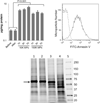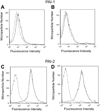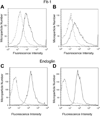Protein composition of microparticles shed from human placenta during placental perfusion: Potential role in angiogenesis and fibrinolysis in preeclampsia
- PMID: 21074265
- PMCID: PMC3762591
- DOI: 10.1016/j.placenta.2010.10.011
Protein composition of microparticles shed from human placenta during placental perfusion: Potential role in angiogenesis and fibrinolysis in preeclampsia
Abstract
Shedding of syncytiotrophoblast microparticles (MPs) from placenta to maternal blood occurs in normal pregnancy and is enhanced during preeclampsia (PE). The syncytiotrophoblast synthesizes plasminogen activator inhibitors (PAIs) which regulate fibrinolysis, as well as soluble forms of the fms-like tyrosine kinase (sFlt-1) and endoglin, which exert anti-angiogenic actions. An increase in the ratio of PAI-1/PAI-2 and elevated levels of sFlt-1 and sEng in maternal serum are linked to placental damage and maternal endothelial cell dysfunction in PE. The goal of the current study was to determine whether MPs released to maternal perfusate during dual perfusion contain these factors associated with placental pathophysiology in PE. Initially, high levels of alkaline phosphatase activity and Annexin V binding were found in MPs isolated by sequential centrifugation of maternal perfusates at 10,000 and 150,000×g(10 K and 150 K MPs), indicating their plasma membrane origin. ELISA revealed the presence of these factors at the following relative levels: Eng>PAI-2⋙PAI-1>sFlt-1. Based on comparisons of their concentration in perfusates, MPs, and MP-free 150 K supernatants, we determined that MPs constitute a significant portion of Eng released by placenta. Flow cytometric analysis of 10 K MPs supported the levels of expression found by ELISA and indicated that Eng and PAI-2 were almost exclusively localized to the surface of MPs, a site with biological potential. These results indicate that MPs shed from the syncytial surface express factors which may alter the fibrinolytic and angiogenic balance at the maternal-fetal interface and play a role in the pathophysiology of PE.
Copyright © 2010 Elsevier Ltd. All rights reserved.
Figures





Similar articles
-
Placental productions and expressions of soluble endoglin, soluble fms-like tyrosine kinase receptor-1, and placental growth factor in normal and preeclamptic pregnancies.J Clin Endocrinol Metab. 2008 Jan;93(1):260-6. doi: 10.1210/jc.2007-1550. Epub 2007 Oct 23. J Clin Endocrinol Metab. 2008. PMID: 17956952 Free PMC article.
-
Differential release of plasminogen activator inhibitors (PAIs) during dual perfusion of human placenta: implications in preeclampsia.Placenta. 2007 Apr;28(4):278-85. doi: 10.1016/j.placenta.2006.05.005. Epub 2006 Jul 3. Placenta. 2007. PMID: 16820203
-
Characterisation of syncytiotrophoblast vesicles in normal pregnancy and pre-eclampsia: expression of Flt-1 and endoglin.PLoS One. 2013;8(2):e56754. doi: 10.1371/journal.pone.0056754. Epub 2013 Feb 20. PLoS One. 2013. PMID: 23437230 Free PMC article.
-
Role of the syncytium in placenta-mediated complications of preeclampsia.Thromb Res. 2009 Sep;124(4):389-92. doi: 10.1016/j.thromres.2009.05.016. Epub 2009 Jun 16. Thromb Res. 2009. PMID: 19535132 Free PMC article. Review.
-
Association of microparticles and preeclampsia.Mol Biol Rep. 2013 Jul;40(7):4553-9. doi: 10.1007/s11033-013-2536-0. Epub 2013 May 6. Mol Biol Rep. 2013. PMID: 23645085 Review.
Cited by
-
Placental extracellular vesicles and feto-maternal communication.Cold Spring Harb Perspect Med. 2015 Jan 29;5(3):a023028. doi: 10.1101/cshperspect.a023028. Cold Spring Harb Perspect Med. 2015. PMID: 25635060 Free PMC article. Review.
-
The promise of placental extracellular vesicles: models and challenges for diagnosing placental dysfunction in utero†.Biol Reprod. 2021 Jan 4;104(1):27-57. doi: 10.1093/biolre/ioaa152. Biol Reprod. 2021. PMID: 32856695 Free PMC article. Review.
-
Pre-eclampsia.Nat Rev Dis Primers. 2023 Feb 16;9(1):8. doi: 10.1038/s41572-023-00417-6. Nat Rev Dis Primers. 2023. PMID: 36797292 Review.
-
Mechanisms of Key Innate Immune Cells in Early- and Late-Onset Preeclampsia.Front Immunol. 2020 Aug 18;11:1864. doi: 10.3389/fimmu.2020.01864. eCollection 2020. Front Immunol. 2020. PMID: 33013837 Free PMC article. Review.
-
Placenta-derived extracellular vesicles induce preeclampsia in mouse models.Haematologica. 2020 Jun;105(6):1686-1694. doi: 10.3324/haematol.2019.226209. Epub 2019 Aug 22. Haematologica. 2020. PMID: 31439676 Free PMC article.
References
-
- Aly AS, Khandelwal M, Zhao J, Mehmet AH, Sammel MD, Parry S. Neutrophils are stimulated by syncytiotrophoblast microvillous membranes to generate superoxide radicals in women with preeclampsia. Am J Obstet Gynecol. 2004;190:252–258. - PubMed
-
- Goswami D, Tannetta DS, Magee LA, Fuchisawa A, Redman CW, Sargent IL, et al. Excess syncytiotrophoblast microparticle shedding is a feature of early-onset pre-eclampsia, but not normotensive intrauterine growth restriction. Placenta. 2006;27:56–61. - PubMed
-
- Gupta AK, Rusterholz C, Huppertz B, Malek A, Schneider H, Holzgreve W, et al. A comparative study of the effect of three different syncytiotrophoblast micro-particles preparations on endothelial cells. Placenta. 2005;26:59–66. - PubMed
-
- Knight M, Redman CW, Linton EA, Sargent IL. Shedding of syncytiotrophoblast microvilli into the maternal circulation in pre-eclamptic pregnancies. Br J Obstet Gynaecol. 1998;105:632–640. - PubMed
-
- Huppertz B, Frank HG, Kingdom JC, Reister F, Kaufmann P. Villous cytotrophoblast regulation of the syncytial apoptotic cascade in the human placenta. Histochem Cell Biol. 1998;110:495–508. - PubMed
Publication types
MeSH terms
Substances
Grants and funding
LinkOut - more resources
Full Text Sources
Other Literature Sources
Medical
Miscellaneous

